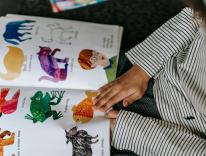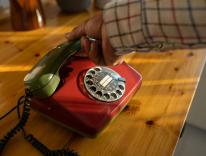“Stay away from Catholic boys,” my father told me. I was about thirteen, sitting in the kitchen while he was making pancakes. We were Presbyterian, but the words struck me as some sort of family code. He said it was not too early to think about these things, and that I would be unhappy if I married a Catholic. “More than likely, you’ll have to convert,” he said, “or at least sign over your children, and they’ll come home from Catholic school spouting all that gibberish.” I knew he was referring to the prayers my Catholic friends recited, the Hail Marys and the Our Fathers.
But I found Catholic boys attractive. I remember seeing them dashing for the bus in their dark slacks and white shirts, different from the boys I went to school with, in Levis and khakis. As a thirteen-year-old, watching high-school kids on a local TV dance show, I was enamored of the boys from Purcell or Roger Bacon. I liked the way they wore their sweaters backwards under their jackets so the ribbing cut high across their shirt collars, giving them, oddly enough, a clerical look.
My mother, who grew up Southern Baptist, was also distrustful of Catholics. “Why, they put Mary right up there with Jesus,” she said, “and that’s wrong.” So was naming new saints. Just who did they think they were, creating new saints? No one but the original apostles should be called a saint. And showing Jesus hanging on the cross: didn’t the Catholics know he’d risen? And praying for the dead: didn’t they know if the dead hadn’t been good Christians, they were going where they were going. Forget about lighting candles.
Despite my parents’ warnings, I had a Catholic boyfriend during college (after all, I was old enough to decide for myself), but I married a Presbyterian. He’d grown up in Berkeley, and he told me that as an eight-year-old he had stood at the front of the sanctuary with his Sunday school class, missed a cue, and remained standing when he should have sat down. He felt ashamed and embarrassed, he said, and never wanted to go back. Sometimes, in jest, he would burst into the first lines of an old Sunday school song: “Oh it’s the B-I-B-L-E / That’s the book for me.” We seldom took our kids to church. My mother gave them Bibles for Christmas and took them to services when we visited. I bought a Revised Standard Version to read alongside the King James Version, because I thought it was interesting, but I began to consider people who believed Jesus was the son of God unenlightened.
My husband passed away after twenty-nine years of marriage, and I married, two years later, one of our friends, a devout Catholic. One of our first dates was a Catholic Christmas Eve Mass. I was stunned at the similarity between the Protestant and Catholic services—both the liturgy and the order of worship. (What had all my parents’ fuss been about? Then again, that was in the days before Vatican II.) I was soon to learn that the Catholics often sang the same hymns. When I hear them now, my eyes sting as I remember the comforting feel of being a child surrounded by adults singing sacred music. I regret that my children so seldom had this experience. I like the homilies the priests deliver, usually from memory. I like the emphasis on Communion. I like the openness of the church library. I like the incense and candles and mystery. I like the potluck dinners, where someone always brings a jug of wine. I find myself interested in the saints, in Thomas Merton, in holy water.
What I find in the Catholic Church is a sense of beauty and order. An unpretentiousness. Our church in Boothbay Harbor was on what was once the poor side of town, where all the canneries were. Inside it’s like a ship turned upside down, with its criss-cross of timbers. The canneries are gone. Now it sits like a white beacon on the hill overlooking the harbor.
My son went through a difficult divorce last year. Before one of the hearings, my husband came upon a prayer to Mary. I don’t usually use intercessory prayer, he said, but we tried it, and it worked—and worked, and worked. I’ve become attuned to the statues of Mary, to the simple shrines I’ve seen people make. Since I found this experience so transforming, I decided to enroll in RCIA. I cannot say I agree with everything the church teaches, but I know through experience that minor differences aren’t a dealbreaker. I know when it’s time to join the enemy.
Please email comments to [email protected] and join the conversation on our Facebook page.
Previous Story
Covenant Keeper
Next Story
Change at the Pentagon


